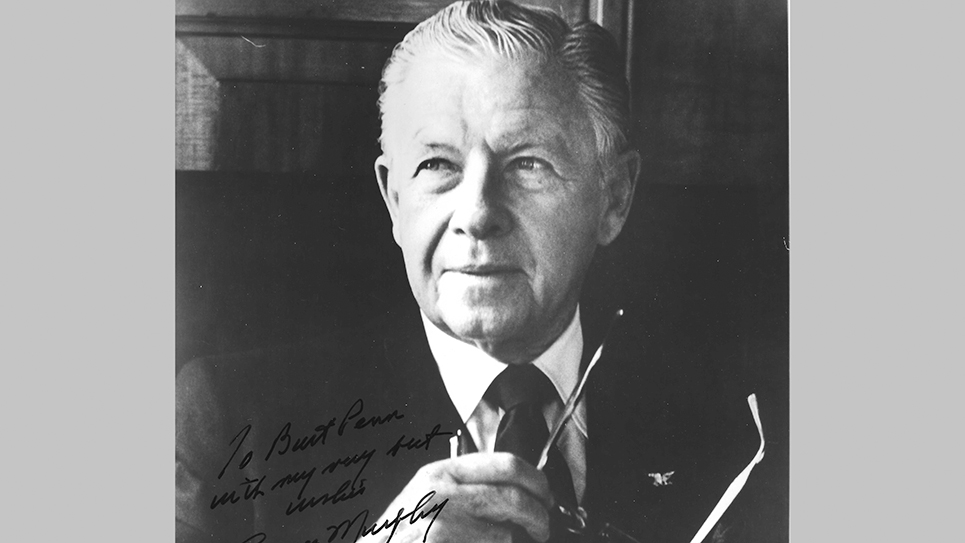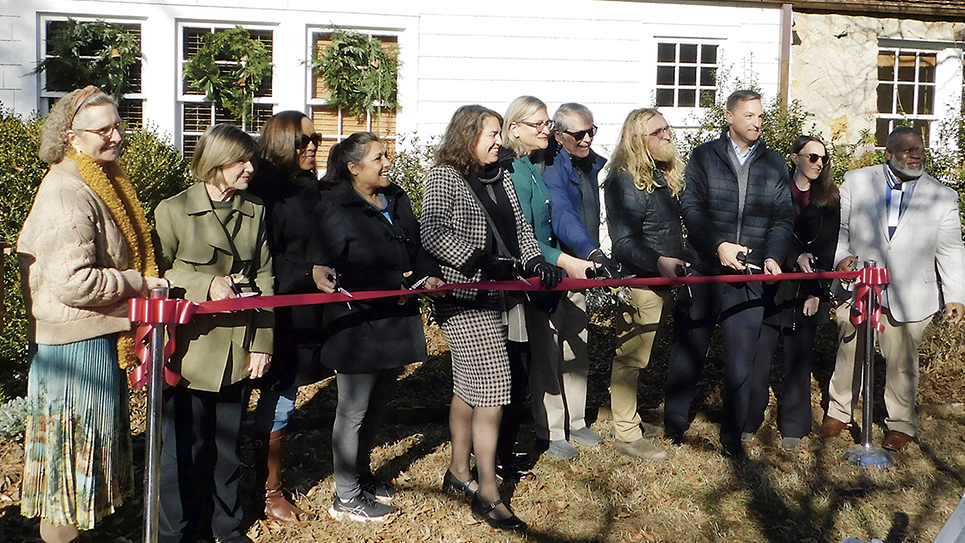Song & Dance Man in the Senate
George Murphy of California
The most notable actor who transitioned to politics was, of course, Ronald Reagan. Later came Arnold Schwarzenegger, who was elected governor. Before either Reagan or Schwarzenegger were elected, there was George Murphy. To get to the United States Senate, Murphy had to buck the national tide as GOP presidential candidate Barry Goldwater was losing badly to incumbent President Lyndon Johnson. Murphy also faced a nationally known candidate in the general election in Pierre Salinger, who had gained notoriety as the press secretary to President John F. Kennedy and his successor in the White House. Johnson was delighted when Salinger decided to go to California to run for the U.S. Senate and paid the candidate’s filing fee to enter the race. Salinger defeated all the Californians who had been running for the Democratic nomination in the primary. The cigar-chomping, portly, jowly, wisecracking Salinger made quite a contrast to the sleek, handsome and polished George Murphy whose silver hair and tailoring gave him the aura of a statesman.
It was George Murphy who began a tradition inside the United States Senate that persists to this day. Murphy liked candy and kept it on his desk on the Senate floor. The Californian invited his colleagues to help themselves and the “candy desk” was born.
Known as “Murph” to his friends, George Murphy was educated at good schools and Yale University in his native Connecticut. After school, he tried his hand at a variety of jobs, which included working for the Ford Motor Company in a factory, a miner, a real estate agent and a dancer in a night club. The athletic Murphy kept dancing and went from Broadway to Hollywood where he headlined many a musical. For twenty-two years, from 1930 until he retired from acting in 1952, Murphy was a popular entertainer and received an honorary Oscar in 1951. Murphy headed the Screen Actors’ Guild before his friend Ronald Reagan, winning the presidency of the union in 1944 and serving until 1946. Following his retirement from acting, George Murphy transitioned into the business end of Hollywood’s biggest business, working as a vice president for the Technicolor Corporation, as well as Desilu, the studio founded by Lucille Ball and her husband, Desi Arnaz.
Murphy had long been an active Republican; with Fred Astaire and Ginger Rogers, he formed the Hollywood Republican Committee. It was George Murphy who directed the inaugurations of President Dwight D. Eisenhower, gathering some of the biggest names in show business at the time.
California was not the bastion of the Democratic Party it has become today. Yet the Golden State’s GOP had fallen upon hard times following a debacle in 1958 brought about by the presidential aspirations of three men: Richard Nixon, William Knowland and Goodwin Knight. In 1958 Nixon was vice president of the United States, Knowland was California’s senior U.S. senator and minority leader of the United States Senate and Knight was governor of California. Nixon was the frontrunner to win the Republican presidential nomination to succeed President Eisenhower in 1960. Knowland blew everything apart by declaring he was running for governor of California in 1958. Knowland reasoned as California’s chief executive, he could control the Golden State’s sizeable delegation to the GOP national convention and have a chance to win the presidential nomination. Senator Knowland made it quite clear he would face off against Goodwin Knight inside the Republican primary if necessary. Eventually, Knight switched to the Senate race to run for Knowland’s seat while the bullheaded minority leader ran for governor. The GOP ticket was wiped out in the general election in a debacle of epic proportions. Knowland lost badly to State Attorney General Edmund “Pat” Brown while Knight lost to Congressman Clair Engle.
Nixon did win the GOP presidential nomination and carried his home state of California in the 1960 election against John F. Kennedy. Losing by a fraction, Richard Nixon sought to regain his foothold in politics by challenging Governor Pat Brown in 1962. Nixon lost decisively.
George Murphy was the favorite for the GOP nomination for the United States Senate, beating industrialist Leland Kaiser and former Kansas Governor Fred Hall in the primary. Senator Clair Engle was stubbornly running for election, although he was seriously incapacitated by a malignant brain tumor. The ailing senator was dying, and State Comptroller Alan Cranston was off and running for the Democratic nomination. Salinger, a native of San Francisco, impulsively entered the race and won the primary. Senator Engle died, and Governor Brown appointed Salinger to fill the vacancy so he could campaign as an incumbent in the general election.
In 1964, Democrats in California outnumbered Republicans 3-2. Murphy’s senatorial campaign was managed by Robert Finch, a former Nixon strategist. Perhaps no state in the union was as image-conscious as California and the contrast between Senator Salinger and George Murphy was stark. Finch was an extremely able campaign manager, carefully guiding the first-time candidate as it became readily apparent LBJ would win the general election in a landslide. For years, Salinger had lived in Virginia, a fact Murphy never failed to point out to voters. While Murphy had endorsed the presidential candidacy of Barry Goldwater, he was also careful to note his differences with the Arizona senator on civil rights legislation and cuts to foreign aid.
The highlight of the 1964 race for the U.S. Senate was a televised debate between the two candidates. Murphy came out looking better than his opponent. On Election Day, George Murphy outran Barry Goldwater by quite nearly 750,000 votes as Lyndon Johnson was carrying California with almost 60% of the ballots cast. Murphy beat Salinger by more than 200,000 votes to win a seat in the United States Senate. Even Governor Pat Brown had to confess Murphy’s campaign had been one of the best he could remember. George Murphy was the only GOP candidate in 1964 to beat an incumbent Democrat to win a seat in the U.S. Senate. The defeated Salinger was philosophical. At age 39, Salinger joked, “I may be the youngest living ex-Senator in history.”
TIME magazine commented after the election, “Senator Murphy’s move from Hollywood to Capitol Hill came only after a great deal of intense personal dedication and strong self-discipline. In the Senate, such qualities should never be underrated.”
Salinger resigned on December 31, 1964, and Governor Pat Brown appointed George Murphy to the U.S. Senate, giving him a slight seniority edge over those colleagues elected in the 1964 election.
Sixty-two years old when first elected to the Senate, George Murphy went to Washington where he remained a celebrity. Senator Murphy concentrated upon issues pertinent to his state and was in high demand as a speaker and fundraiser for other Republicans across the country. Murphy’s colleagues selected him to chair the Republican Senatorial Campaign Committee and the GOP picked up several seats in the U.S. Senate in the 1966 election cycle, including one in Tennessee.
George Murphy faced several difficulties during his term in the Senate. Murphy underwent surgery for throat cancer and for the remainder of his life could not speak above a whisper. Murphy’s wife, Julie, was ailing and the senator was known for his devotion to her. The Murphys had two children together. Each weekend, Murphy made the grueling flight from Washington, D.C. to their home in Beverly Hills, California, to be with his wife. Each Sunday night, Senator Murphy boarded the “red eye” flight back to Washington for work.
Murphy was reputedly the prototype for Crocker Jarman, the fictional U.S. senator in Robert Redford’s movie “The Candidate.” Senator Murphy began his 1970 reelection campaign as the favorite, easily dispatching a quixotic challenge from millionaire businessman Norton Simon inside the Republican primary. Murphy faced Congressman John Tunney, the son of heavyweight champion Gene Tunney. Tunney was no Pierre Salinger; quite the contrary. Young, handsome and articulate, the congressman was a critic of the Vietnam War, while Senator Murphy remained a supporter of President Nixon’s war policy. Murphy’s reelection bid was hampered not only by his inability to speak above a whisper but also by reports he had remained on Technicolor’s payroll while a member of the U.S. Senate. There were reports at the time Murphy was paid $20,000 annually (roughly $161,000 today) as a public relations consultant, provided a $230 monthly allowance for rent and the use of a credit card. Of course, many members of Congress derived outside income from law practices and businesses and Senator John Stennis of Mississippi, Chairman of the Senate’s Select Committee on Standards and Conduct, had already given his stamp of approval to the arrangement. A goodly number of Independents in California looked upon the arrangement with disapproval.
Murphy’s ticket-mate in the 1970 election was Ronald Reagan, who had been elected governor in 1966. Reagan was facing a hard race of his own against the powerful Speaker of the California General Assembly, Jess Unruh. Reagan had succeeded Murphy as president of the Screen Actors’ Guild and there had been a time when the two had violently disagreed about Communists lurking inside the movie community. Reagan later acknowledged Murphy had strongly influenced him in noticing “strange creatures crawling from under the make-believe rocks in our make-believe town.” Initially, Ronald Reagan had been furious with Murphy and dismissed him as “an arch reactionary.” Reagan, at the time, had been a Democrat, while George Murphy was a proud Republican. Murphy refused to give up and eventually Reagan opened his eyes and recognized what was happening inside his own union. George Murphy and Ronald Reagan became friends and each strongly backed the other politically.
Following the GOP electoral successes in the 1966 election, George Murphy was the toastmaster at the most successful fundraiser in the history of the Republican Party up until that time. Two thousand guests filled the ballroom of Washington’s Hilton Hotel at $500 per plate (roughly $4,600 today), which raised $1 million in a single night. “Here’s your chance to sit in the presence of the next President of the United States,” Senator Murphy told the audience.
Every major GOP presidential contender for 1968 attended, including Richard Nixon, Governor Nelson Rockefeller of New York, and Governor Ronald Reagan of California. It was Reagan who wowed the crowd after having won the “biggest applause of the night” according to TIME magazine.
Perhaps encouraged by the success of George Murphy and Ronald Reagan, Shirley Temple Black announced her candidacy for the House of Representatives when Congressman J. Arthur Younger died in 1967. George Murphy had danced with the moppet Shirley Temple in the movies and she had starred in “That Hagen Girl” with Ronald Reagan. While Mrs. Black didn’t win that special election, she later became a diplomat and served as the United States Ambassador to Ghana and later, under President George H. W. Bush, to Czechoslovakia.
Governor Ronald Reagan was reelected in 1970 while George Murphy was upset in his reelection bid by John Tunney. Following his defeat for reelection, George Murphy became a consultant and worked past 80. Murphy’s wife had died but love found the former song and dance man once again in 1982 when the former senator was 79. Bette Blandi was a former Powers model who confessed she had been torn when Murphy asked her to marry him. Blandi told her 26-year-old daughter, Debra, “I can’t marry an 80-year-old man.” Debra looked at her mother and replied, “If you don’t want him, I’ll take him.” Later Bette Murphy laughed and said, “I’m glad I married the old geezer.”
Murphy lived in Palm Beach, Florida, with his second wife and they built another home in the North Carolina mountains near Asheville. Murphy was still working in Washington, D.C., at the time. The former senator and movie star died in 1992 at age 89 from leukemia.
From waiting tables and stoking furnaces, attending Yale, singing and dancing on the silver screen and sitting in the United States Senate, George Murphy lived a full life. © 2024 Ray Hill







